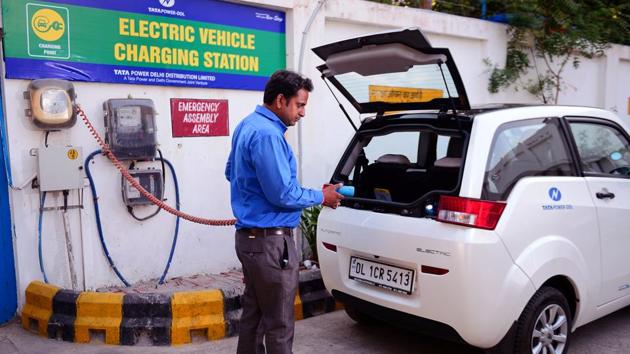Charging infra and green power must for switch to e-vehicles
Electric vehicles can help because they have zero tailpipe emissions and can reduce the dangerous nitrogen-oxide and particulate matter in the air. They also offer quieter and smoother rides. The new draft policy’s focus on electrifying two-wheelers, besides auto-rickshaws, cabs, goods carriers and public buses, could address a big problem.
The Delhi government has put its new draft policy on electric vehicles — which sets an ambitious target of electrifying 25% of all new vehicles registered by 2023 — in public domain for suggestions. While the details of the initiative are being debated, nobody disputes the urgency to fight the air pollution asphyxiating Delhi residents.

Electric vehicles can help because they have zero tailpipe emissions and can reduce the dangerous nitrogen-oxide and particulate matter in the air. They also offer quieter and smoother rides. The new draft policy’s focus on electrifying two-wheelers, besides auto-rickshaws, cabs, goods carriers and public buses, could address a big problem.
Out of 7.3 million motorcycles and scooters registered in Delhi, at least three million run on the polluting BS-III engines. While now, vehicles with only cleaner BS-IV engines are being registered, banning the older, polluting two-wheelers is difficult as much of the city’s working class depends on them for their daily commute.
With the right pricing, e-scooters could emerge as an efficient, pollution-free option, say experts. But a switch to e-mobility would take a lot more than just buying and putting e-vehicles on the road. The biggest challenge is to keep them running.
Delhi’s private power distribution companies, which will have to provide the vehicle charging infrastructure, say they are prepared to pull the weight. But they also flag concerns. The power lines carrying the existing load will also be used for EV charging and there are fears of overloading if the network is not shored up accordingly. Also, before they start upgrading, power companies say they will have to determine the demand in each zone, which will depend on how many vehicles are being bought in those areas.
At the same time, until e-vehicles source power from green energy, the switchover cannot be dubbed entirely green. But can we really wait to clean up our coal plants before bringing in e-vehicles? The vehicular pollution problem in the city and emissions from coal-powered plants across the country must be addressed simultaneously.
The best way to clean the power grid is to increase the share of renewable energy, mainly solar and wind. Right now, Delhi has only 3% of its power sourced from the renewables and as much as 62-67% comes from coal. While it has shut down its own coal-fired Badarpur plant two months ago, the Delhi government says it is making efforts to reduce dependence on older, inefficient thermal units located outside the city.
If all goes well, Delhi will source as much as 18% of its electricity from renewables from next year. Dedicated green corridors have made transmission of renewable energy from plants to the grid much cheaper. The push to rooftop solar installations in residential and government buildings and the schemes such as giving incentives to city farmers to install panels on their farmland could increase the generation locally.
Experts point out that charging EVs at the right time — say, when solar and wind energy generation is at its peak — can increase the consumption of renewable energy and also improve the stability of the grid. For this, distribution companies say they would require customised time-of-day metering tariffs just for e-vehicle users.
Even as the Delhi government takes the lead in promoting e-vehicles, for a better reach, the e-mobility plan requires similar efforts by the Uttar Pradesh and the Haryana governments. Many families with multiple daily commuters between Delhi and the suburban National Capital Region use more than one vehicle. Lack of charging infrastructure in the NCR towns may discourage them from switching to e-vehicles. More than 16 years since its introduction, the CNG is still not a popular fuel option in the NCR towns because of a shortage of dispensing stations.
Delhi has long squandered the benefits of CNG switchover (in 2002, it had the world’s largest fleet of public transport running on the green fuel) by adding too many private vehicles since. While replacing some of these with electric vehicles may ease pollution, it will not solve the problems of congestion and parking. The real success of the clean air initiative would depend on how aggressively the government pushes electrification of public buses and augments the tried-and-tested humble CNG bus service.
Stay updated with all top Cities including, Bengaluru, Delhi, Mumbai and more across India. Stay informed on the latest happenings in World News along with Delhi Election 2025 and Delhi Election Result 2025 Live, New Delhi Election Result Live, Kalkaji Election Result Live at Hindustan Times.
Stay updated with all top Cities including, Bengaluru, Delhi, Mumbai and more across India. Stay informed on the latest happenings in World News along with Delhi Election 2025 and Delhi Election Result 2025 Live, New Delhi Election Result Live, Kalkaji Election Result Live at Hindustan Times.






